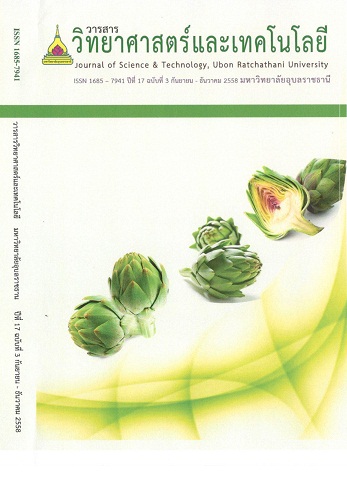Spray-drying for Inulin Powder Production from Jerusalem Artichoke Tuber Extract and Product Qualities
Main Article Content
บทคัดย่อ
Inulin is a polysaccharide that has functional properties as a prebiotic. In this study, inulin was extracted from Jerusalem artichoke (JA) tubers and then spray-dried to become a powder form. The key aims of this study were to determine the suitable spray-drying conditions and the inulin powder qualities. The inulin extracts at concentrations of 10, 20, and 30 ºBrix were spray-dried using the inlet/outlet drying temperatures at 150/90ºC. As a result, the feed material at 30 ºBrix provided good characteristics of inulin powder with high powder recovery and low moisture content. Then the drying experiments were conducted at inlet air temperatures of 150, 170, and 190ºC whereas the outlet air temperature and the JA extract concentration were fixed at 90°C and 30 ºBrix. It appeared that the drying temperature of 190°C was more appropriate than 150°C and 170°C because it provided higher powder recovery, lower moisture content, better solubility and absorptivity, and more stability of powder. The SEM micrographs showed that the inulin powders produced by the spray-drying temperatures at 150 and 170°C had more sphere-shaped and had attached particles than those at 190°C.
อินูลินเป็นพอลิแซ็กคาไรด์ซึ่งมีคุณสมบัติเชิงหน้าที่เป็นพรีไบโอติกในการศึกษานี้ อินูลินถูกสกัดจากหัวแก่นตะวันแล้วถูกทำแห้งแบบพ่นฝอยเพื่อแปรรูปเป็นผลิตภัณฑ์ผง วัตถุประสงค์หลักของการศึกษานี้คือ เพื่อหาสภาวะการทำแห้งแบบพ่นฝอยที่เหมาะสมและคุณภาพของอินูลินผง สารสกัดอินูลินที่มีความเข้มข้น 10, 20 และ 30°บริกซ์ถูกนำมาทำแห้งแบบพ่นฝอย โดยใช้อุณหภูมิลมร้อนขาเข้าและขาออกที่ 150 และ 90 องศาเซลเซียส ตามลำดับ ผลการทดลองแสดงให้เห็นว่า การใช้สารสกัดที่มีความเข้มข้น 30°บริกซ์ ให้ผลิตภัณฑ์อินูลินผงที่มีลักษณะดี ได้ปริมาณผลผลิตสูงและผงที่ได้มีความชื้นต่ำ หลังจากนั้นได้ทดลองทำแห้งโดยใช้อุณหภูมิลมร้อนขาเข้าที่ 150, 170 และ 190 องศาเซลเซียส ในขณะที่อุณหภูมิลมร้อนขาออกและความเข้มข้นของสารสกัดจากแก่นตะวันถูกกำหนดที่ 90 องศาเซลเซียสและ 30°บริกซ์ตามลำดับ ผลปรากฏว่า อุณหภูมิลมร้อนขาเข้าที่ระดับ 190 องศาเซลเซียส มีความเหมาะสมมากกว่า 150 และ 170 องศาเซลเซียส เพราะให้ปริมาณผลผลิตสูงกว่า ผลิตภัณฑ์ผงมีความชื้นต่ำกว่า มีความสามารถในการละลายและค่าการดูดซับดีกว่า และมีความคงตัวมากกว่า ภาพจากกล้องจุลทรรศน์อิเล็กตรอนแบบส่องกราด (SEM) แสดงให้เห็นว่าผงอินูลินที่ผลิตโดยการทำแห้งแบบพ่นฝอยที่อุณหภูมิลมขาเข้า150 และ 170 องศาเซลเซียส มีรูปทรงที่กลมมากกว่า และมีการเกาะติดกันของอนุภาคมากกว่ากรณีที่ใช้อุณหภูมิลมขาเข้าที่ 190 องศาเซลเซียส
Article Details
บทความที่ได้รับการตีพิมพ์เป็นลิขสิทธิ์ของ วารสารวิทยาศาสตร์และเทคโนโลยี มหาวิทยาลัยอุบลราชธานี
ข้อความที่ปรากฏในบทความแต่ละเรื่องในวารสารวิชาการเล่มนี้เป็นความคิดเห็นส่วนตัวของผู้เขียนแต่ละท่านไม่เกี่ยวข้องกับมหาวิทยาลัยอุบลราชธานี และคณาจารย์ท่านอื่นๆในมหาวิทยาลัยฯ แต่อย่างใด ความรับผิดชอบองค์ประกอบทั้งหมดของบทความแต่ละเรื่องเป็นของผู้เขียนแต่ละท่าน หากมีความผิดพลาดใดๆ ผู้เขียนแต่ละท่านจะรับผิดชอบบทความของตนเองแต่ผู้เดียว


